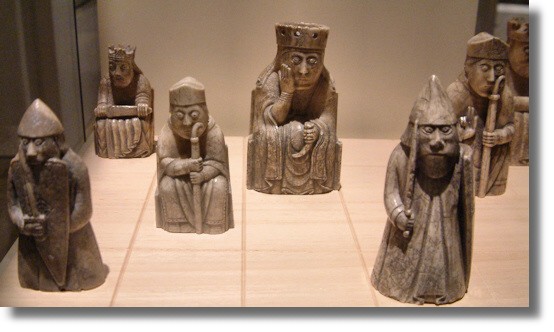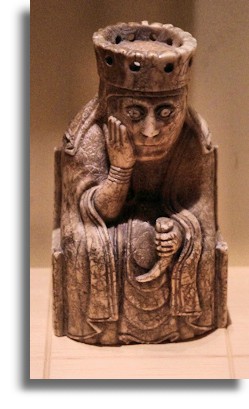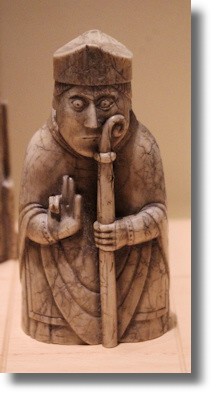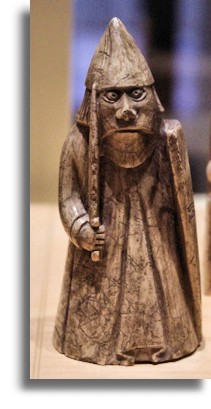
Lewsis Chess Men in the Museum of Scotland

Discovery
The Lewis Chessmen are a group of 78, 12th-century chess pieces, most of which are carved in walrus ivory. They were uncovered in 1831 on the Isle of Lewis in the Outer Hebrides, Scotland. They may constitute some of the few, surviving medieval chess sets. The chessmen were discovered in a sand bank at the head of Camas Uig on the west coast of the Isle of Lewis, in the Outer Hebrides of Scotland. There are various local stories concerning their arrival and modern discovery on Lewis. The Western Isles has a long tradition of storytelling so it is not surprising that many stories sprang up about how they got there. The ivory doesn't appear to have been worn through long use, so there is speculation that they constituted a merchant's trade goods rather than belonging to someone who had used them to play chess.It was a Malcolm Macleod from the nearby township of Pennydonald who is usually credited with the discovery of the trove in a small stone kist (chest) in a dune. He exhibited them briefly in his byre and then sold them on to Captain Roderick Ryrie who was probably the first to realise the significance of the find.
Roderick Ryrie brought a total of 93 ivory pieces to Edinburgh - 78 chessmen, 13 plain disks used in another board game and a buckle, decorated with leaves. The 78 chess pieces may represent parts of four chess sets, with some missing pieces. There were early reports that some of them had red staining - presumably to distinguish between the opposing pieces.
The hoard was bought from Ryrie by an Edinburgh dealer who subsequently sold the bulk of them to the British Museum in London but luckily not before he had sold ten to an Edinburgh collector, Charles Kirkpatrick Sharpe. Sharpe later found another bishop to take his collection up to eleven, all of which were later sold to Lord Londesborough. In 1888 they were again sold, this time to the Society of Antiquaries of Scotland, who donated the pieces to the Royal Museum in Edinburgh. The eleven are now on display in the Museum of Scotland.

Where Were The Chessmen Originally Made?
As with other aspects of the Lewis Chessmen, there is some debate about where they were originally made. There is a fair amount of evidence that they were made in Scandinavia, probably Trondheim in Norway.The evidence includes a broken queen piece in a similar style found in an excavation of the archbishop's palace there and the presence of wealthy people in Trondheim able to pay craftsmen for such high-quality pieces. There is similar carving in Nidaros Cathedral in Trondheim and kite-shaped shield similar to shields on some of the pieces has been found buried in Trondheim. A king piece of similar design found has been found on Hitra Island, near the mouth of Trondheim Fjord. Finally, the armour worn by the chess figures includes "perfect" reproductions of armour worn at the time in Norway.
The aspect which clinches it for many experts is that four of the rooks (also known in early times as warders), holding a shield and sword are shown as wild-eyed "berserkers" - biting their shields with battle fury - apparently a characteristic of Vikings from Trondheim. There is a "berserker" on the left of the graphic at the top of this page.
The chessmen have been dated to the third quarter of the twelfth century on the basis of the clothing and other design factors - the mitres worn by the bishops are of a design adopted around 1150 and there is a lack of heraldry on the shields of knights and warriors - heraldic designs were appearing before the end of the 12th century.
While the chessmen were most likely to have been made in Norway, it should be remembered that in the 12th century lewis was ocupied by the Vikings - who settled as far south as Dublin in Ireland and the Isle of Man, half way between Ireland and England. After King Haakon of Norway was defeated by King Alexander III at the Battle of Largs in 1263, the Western Isles passed to the Scottish king in 1266 under the Treaty of Perth.

The Chess Pieces
Almost all of the pieces in the collection are carved from walrus ivory, with a few made instead from whale teeth. The 78 pieces consist of 8 kings, 8 queens, 16 bishops, 15 knights, 12 rooks and 19 pawns. The heights of the pawns range from 3.5 to 5.8 cm while the major pieces are between 7 and 10.2 cm.There is a picture of the group of chess pieces in the Museum of Scotland at the top of the page and going down this page, the illustrations are of a queen, a bishop and a pawn.



